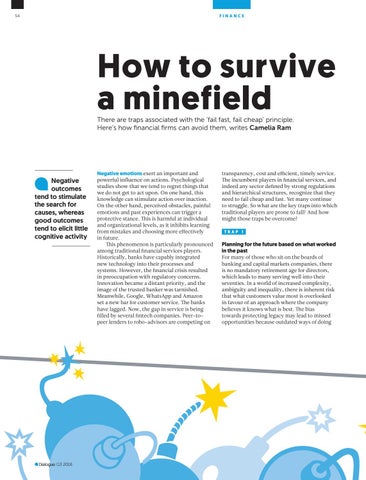FINANCE
54
How to survive a minefield There are traps associated with the ‘fail fast, fail cheap’ principle. Here’s how financial firms can avoid them, writes Camelia Ram
Negative outcomes tend to stimulate the search for causes, whereas good outcomes tend to elicit little cognitive activity
Dialogue Q3 2018
Negative emotions exert an important and powerful influence on actions. Psychological studies show that we tend to regret things that we do not get to act upon. On one hand, this knowledge can stimulate action over inaction. On the other hand, perceived obstacles, painful emotions and past experiences can trigger a protective stance. This is harmful at individual and organizational levels, as it inhibits learning from mistakes and choosing more effectively in future. This phenomenon is particularly pronounced among traditional financial services players. Historically, banks have capably integrated new technology into their processes and systems. However, the financial crisis resulted in preoccupation with regulatory concerns. Innovation became a distant priority, and the image of the trusted banker was tarnished. Meanwhile, Google, WhatsApp and Amazon set a new bar for customer service. The banks have lagged. Now, the gap in service is being filled by several fintech companies. Peer-topeer lenders to robo-advisors are competing on
transparency, cost and efficient, timely service. The incumbent players in financial services, and indeed any sector defined by strong regulations and hierarchical structures, recognize that they need to fail cheap and fast. Yet many continue to struggle. So what are the key traps into which traditional players are prone to fall? And how might those traps be overcome? TRAP 1
Planning for the future based on what worked in the past For many of those who sit on the boards of banking and capital markets companies, there is no mandatory retirement age for directors, which leads to many serving well into their seventies. In a world of increased complexity, ambiguity and inequality, there is inherent risk that what customers value most is overlooked in favour of an approach where the company believes it knows what is best. The bias towards protecting legacy may lead to missed opportunities because outdated ways of doing
